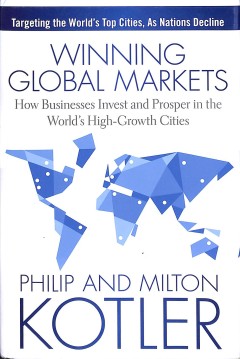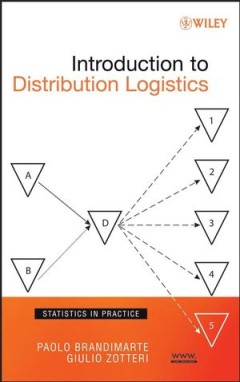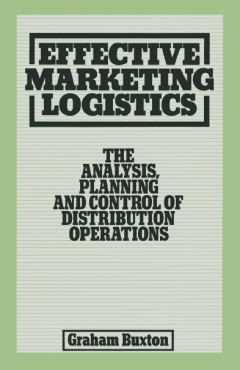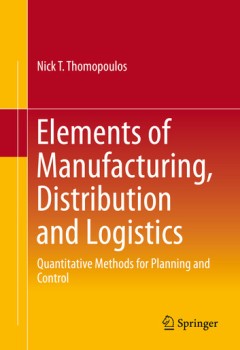Ditapis dengan

Inland Waterway Freight Transport in the UK
Inland waterways play a much greater role in inland freight carrying in the United Kingdom than is generally realised. The purpose of this article is to show the extent of the underestimation of water transport and to outline the potential for future development and the problems which will have to be overcome to realise that potential.
- Edisi
- Vol. 14 Iss 3 pp. 45 - 54 2007
- ISBN/ISSN
- -
- Deskripsi Fisik
- 11 P
- Judul Seri
- International Journal of Physical Distribution & Materials Management
- No. Panggil
- ATC PO COL i

Twenty years of IJLM: evolution in research
The purpose of this paper is to evaluate research trends observed in the International Journal of Logistics Management (IJLM) during its first 20 years of publication. Design/methodology/approach – A content analysis was conducted of the IJLM’s first 20 years of publication (330 articles in total) to identify changing trends in subject matter, use of theory, type of research methodology, an…
- Edisi
- Vol. 23 No. 1, 2012 pp. 4-30
- ISBN/ISSN
- 0957-4093
- Deskripsi Fisik
- 29 p.
- Judul Seri
- The International Journal of Logistics Management
- No. Panggil
- ATC LO TRO t C.1

Using the “documentary method” to analyse qualitative data in logistics r…
This paper aims to examine the use of a qualitative data analysis technique, the documentary method, in the development of knowledge in logistics. The value of the method is illustrated through an example of its application in a study of in-store logistics processes at six leading European retail stores.
- Edisi
- Vol. 42 No. 8/9, 2012 pp. 828-842
- ISBN/ISSN
- 0960-0035
- Deskripsi Fisik
- 17 p.
- Judul Seri
- International Journal of Physical Distribution & Logistics Management
- No. Panggil
- ATC LO TRA u C.1

Virtual logistics- transport in the marketspace
While transport seems to be increasingly constrained in its mission to supply services which are continuous, costless and available in all directions, the telecommunications system seems to have no such constraints and to be developing ever more rapidly in terms of inter‐connectivity, falling costs and multi‐directionality. It would seem to be impossible to contemplate the future demand for…
- Edisi
- Vol. 28 No. 7, 1998, pp. 547-574,
- ISBN/ISSN
- 0960-0035
- Deskripsi Fisik
- 30 p.
- Judul Seri
- International Journal of Physical Distribution & Logistics Management
- No. Panggil
- ATC LO CRO v C.1

World-class logistics- Australia and New Zealand
This paper reports on a study of the logistics and supply chain practices of Australian and New Zealand firms.
- Edisi
- Vol. 35 No. 1, 2005 pp. 63-74
- ISBN/ISSN
- 0960-0035
- Deskripsi Fisik
- 14 p .
- Judul Seri
- International Journal of Physical Distribution & Logistics Management
- No. Panggil
- ATC LO MOL w

Environmental sustainability in the third-party logistics (3PL) industry
The purpose of this paper is to document the extent to which large third-party logistics (3PL) companies have committed themselves to environmental sustainability goals. It also aims to examine the sustainability initiatives undertaken by those companies and the impact of those initiatives on the 3PL and their customers. Finally, the research seeks to examine the impact of the global recession …
- Edisi
- Vol. 40 No. 7, 2010 pp. 524-533
- ISBN/ISSN
- -
- Deskripsi Fisik
- 14 pages
- Judul Seri
- International Journal of Physical Distribution & Logistics Management
- No. Panggil
- ATC LO LIE e

Clustering analysis prioritization of automobile logistics services
The purpose of this paper is to provide a clustering approach to segment supply chain partners in the automobile industry and prioritize services offered by third party logistics service (3PL) providers
- Edisi
- Vol. 110 No. 5, 2010 pp. 731-743
- ISBN/ISSN
- 0263-5577
- Deskripsi Fisik
- 15 p.
- Judul Seri
- Industrial Management & Data Systems
- No. Panggil
- ATC LO TRA c C.1

The difference between elderly consumers’ satisfaction levels and retail sa…
Suggests that a significant trend affecting American society today is the dramatic rise in the number of persons aged over 65. Consequently, retailers are interested in knowing how this segment can be best served in the marketplace. Outlines a study which utilized person perception theory to examine how retail sales personnel’s perceptions relate to elderly consumers’ satisfaction. Results …
- Edisi
- Volume 25 · Number 4 · 1997 · pp. 126–137
- ISBN/ISSN
- 0959-0552
- Deskripsi Fisik
- 14 p .
- Judul Seri
- International Journal of Retail & Distribution Management
- No. Panggil
- ATC LE JOH t C.1

The importance of country-of-origin information and perceived product quality…
There has been a proliferation of studies on product perceptions based on the country of origin. Most of these studies were conducted in western or developed countries. Studies in the less developed nations are still scarce, especially research conducted in the former Soviet Union. With the disintegration of the Soviet Union, the former Soviet republics offer vast new market opportunities for …
- Edisi
- Volume 25 · Number 4 · 1997 · pp. 138–145
- ISBN/ISSN
- 0959-0552
- Deskripsi Fisik
- 10 p.
- Judul Seri
- International Journal of Retail & Distribution Management
- No. Panggil
- ATC MG ZAI t C.1

European Monetary Union: the need for a contingency strategy within the retai…
The decision on which countries will participate in European Monetary Union (EMU) is to take place as early as possible in 1998, with the final run-in, regarding the technicalities of introducing a single currency, starting on 1 January 1999. With this timetable in mind, examines some of the major issues which will have to be confronted by UK retailers. Even if the UK Government decides to opt…
- Edisi
- Volume 25 · Number 4 · 1997 · pp. 146–158
- ISBN/ISSN
- 0959-0552
- Deskripsi Fisik
- 15 p.
- Judul Seri
- International Journal of Retail & Distribution Management
- No. Panggil
- ATC MG ALE e C.1

Enterprise logistics: the right tool for the job
With ever‐increasing profit and competitive pressures, manufacturers are looking toward the logistics process as a source of competitive advantage. A number of methodologies and information systems have evolved as ‘tools’ to aid in the exploitation of the potential of logistics. Many manufacturers have benefited significantly from the application of logistics tools. For others, primarily …
- Edisi
- Vol. 1 Issue: 2, pp.41-46
- ISBN/ISSN
- -
- Deskripsi Fisik
- 8 p.
- Judul Seri
- The International Journal of Logistics Management
- No. Panggil
- ATC LO WOL e

Winning global markets : how business invest and prosper in the world's high-…
A new marketing paradigm focuses on the concentrated economic power of 600 global City-Centered Marketing: Why Local is the Future of Global Business is a compelling practical analysis of a new direction of marketing within the context of intensifying urbanization and the shift of global economy from West to East. Philip Kotler, one of the world's foremost marketing experts, and his bro…
- Edisi
- -
- ISBN/ISSN
- 978-1-118-89381-4
- Deskripsi Fisik
- xxi, 264 p., ; illus : 24 cm ; index
- Judul Seri
- -
- No. Panggil
- LC 658.8 KOT w

World container port throughput follows lognormal distribution
We show in this paper that the throughput data for the top 300 container ports reported each year by the various authorities follows a simple truncated lognormal distribution. This surprising phenomenon repeats itself every year from 1982 to 2006, despite many tumultuous changes in the container shipping world. The empirical data suggests that Gibrat’s Law of proportionate growth indeed holds…
- Edisi
- VOL. 37, NO. 4, 401–426
- ISBN/ISSN
- 1464–5254
- Deskripsi Fisik
- 28 p.
- Judul Seri
- Maritime Policy & Management: The flagship journal of international shipping and port research
- No. Panggil
- ATC LO DIN w

Integrating intermodal transport with logistics: a case study of the UK retai…
Retail traffic is one of the main drivers for the growth of intermodal transport services in the UK. This paper examines the key factors underpinning this modal shift in order to learn lessons for other market and geographical contexts. Since successful retail intermodal logistics involves many actors, this paper is based on semi-structured interviews with major UK retailers, third-party logist…
- Edisi
- Vol. 38, No. 3, 347–374
- ISBN/ISSN
- -
- Deskripsi Fisik
- 29 p.
- Judul Seri
- Integrating intermodal transport with logistics
- No. Panggil
- ATC LO MON i

Hybrid Estimation of Distribution Algorithm for the Quay Crane Scheduling Pro…
The competitiveness of a container terminal is highly conditioned by the time that container vessels spend on it. The proper scheduling of the quay cranes can reduce this time and allows a container terminal to be more attractive to shipping companies. The goal of the Quay Crane Scheduling Problem (QCSP) is to minimize the handling time of the available quay cranes when performing the tasks of …
- Edisi
- 2013
- ISBN/ISSN
- 4063–4076
- Deskripsi Fisik
- 14 p.
- Judul Seri
- Applied Soft Computing
- No. Panggil
- ATC LO IZQ h

CONNECTING SMALL AND MEDIUM ENTERPRISES TO THE GLOBAL MARKET VIA THE GLOBAL L…
Developing countries, such as Taiwan, Singapore and Korea, are transforming to a multi-faceted consumer economy where financial services, medical services, research and development, education, distribution services, international business, technology product development and design, and retail development are fueling economic growth. The logistic and distribution services as a result have become…
- Edisi
- Vol. 19, No. 5, pp. 75-87 (2002)
- ISBN/ISSN
- -
- Deskripsi Fisik
- 15 p.
- Judul Seri
- Journal of the Chinese Institute of Industrial Engineers
- No. Panggil
- ATC LO HOU c

BAK Je-gha’s Thoughts on Logistics and Overseas Commerce in The 18th Centur…
BAK Je-gha is one of distinguished Silhakjas(Korean pragmatic confucianists) in the 18th century in Korea. The most important thoughts of BAK Je-gha lay in his words that properties could be increased by way of investment like a well and agriculture is like intestines and the wagon is like blood vessels in the human body. These are foresighted in that it nearly equals to Say’s words; “sup…
- Edisi
- Volume 25 NUmber 1 June 2009 pp.139-163
- ISBN/ISSN
- -
- Deskripsi Fisik
- 26 P.
- Judul Seri
- -
- No. Panggil
- ATC LO KIM b

An RFRS that combines RFID and CBR technologies
The purpose of this paper is to propose a real-time food receiving operations management system (RFRS), focusing on demonstrating the use of a case-based reasoning (CBR) and radio frequency identification (RFID) technology in managing the complex food receiving activities in distribution centers, to deal with the global concerns in food safety management
- Edisi
- Vol. 112 No. 3, 2012 pp. 385-404
- ISBN/ISSN
- 0263-5577
- Deskripsi Fisik
- 22 p.
- Judul Seri
- Industrial Management & Data Systems
- No. Panggil
- ATC LO CHO a

Measuring the competitiveness of container ports: logisticians' perspectives
- Edisi
- Vol. 45 No. 3, 2011
- ISBN/ISSN
- 0309-0566
- Deskripsi Fisik
- 18 p.
- Judul Seri
- European Journal of Marketing
- No. Panggil
- ATC MG YEO m
- Edisi
- Vol. 45 No. 3, 2011
- ISBN/ISSN
- 0309-0566
- Deskripsi Fisik
- 18 p.
- Judul Seri
- European Journal of Marketing
- No. Panggil
- ATC MG YEO m

Introduction to distribution logistics
- Edisi
- -
- ISBN/ISSN
- 978-0-471-75044-4
- Deskripsi Fisik
- -
- Judul Seri
- -
- No. Panggil
- TXT LO BRA i
- Edisi
- -
- ISBN/ISSN
- 978-0-471-75044-4
- Deskripsi Fisik
- -
- Judul Seri
- -
- No. Panggil
- TXT LO BRA i

Effective marketing logistics: the analysis, planning and control of distribu…
- Edisi
- -
- ISBN/ISSN
- 978-1-349-02101-7
- Deskripsi Fisik
- -
- Judul Seri
- -
- No. Panggil
- TXT LO BUX e
- Edisi
- -
- ISBN/ISSN
- 978-1-349-02101-7
- Deskripsi Fisik
- -
- Judul Seri
- -
- No. Panggil
- TXT LO BUX e

Elements of danufacturing, distribution and logistics: quantitative methods f…
- Edisi
- -
- ISBN/ISSN
- 978-3-319-26862-0
- Deskripsi Fisik
- -
- Judul Seri
- -
- No. Panggil
- TXT LO THO e
- Edisi
- -
- ISBN/ISSN
- 978-3-319-26862-0
- Deskripsi Fisik
- -
- Judul Seri
- -
- No. Panggil
- TXT LO THO e

International logistics
- Edisi
- -
- ISBN/ISSN
- 978-1-4615-2085-6
- Deskripsi Fisik
- -
- Judul Seri
- -
- No. Panggil
- TXT LO Woo i
- Edisi
- -
- ISBN/ISSN
- 978-1-4615-2085-6
- Deskripsi Fisik
- -
- Judul Seri
- -
- No. Panggil
- TXT LO Woo i

Perspective supply chain logistics initiatives research implications
Intends to provide insights from observaions of field practices and initiatives from researchers in supply chain logistics seeking contexts and inspiration for future research.
- Edisi
- Vol. 35 No. 3, 2005
- ISBN/ISSN
- -
- Deskripsi Fisik
- 6 p .
- Judul Seri
- International Journal of Physical Distribution & Logistics Management
- No. Panggil
- ATC LO CAV p

The North American third party logistics industry in 2004: the provider CEO p…
Our annual surveys seek to provide insight into important market dynamics, opportunities and problems in the North American third party logistics (3PL) industry, from the perspective of the chief executive officers (CEOs) of major logistics service companies. The information generated is not only useful to managers considering using such services, but also to provider CEOs to facilitate industr…
- Edisi
- Vol. 35 No. 8, 2005
- ISBN/ISSN
- -
- Deskripsi Fisik
- 20 p.
- Judul Seri
- International Journal of Physical Distribution & Logistics Management
- No. Panggil
- ATC LO BEN t

Efficiency of trucks in logistics: technical efficiency and scale efficiency
The purpose of this paper is to propose a scheme to estimate the technical efficiency of trucks engaged in logistics and to analyze the properties of efficiency. The objectives are to determine individual-truck level technical efficiency using both radial and non-radial measures for freight trucks, to calculate the degree of input overuse.
- Edisi
- Vol. 11 No. 1, 2010
- ISBN/ISSN
- -
- Deskripsi Fisik
- 10 p.
- Judul Seri
- Asian Journal on Quality
- No. Panggil
- ATC LO KIM e

Distribution network design: a literature review and a research agenda
The purpose of this paper is threefold. First, it classifies research on distribution network design (DND) according to the methodologies adopted and themes tackled. Second, it discusses the main implications for practitioners. Finally, it proposes a few promising directions for future research.
- Edisi
- Vol. 45 No. 5, 2015
- ISBN/ISSN
- -
- Deskripsi Fisik
- 28 p .
- Judul Seri
- International Journal of Physical Distribution & Logistics Management
- No. Panggil
- ATC LO PER d

Distribution and logistics development in China: The revolution has begun
- Edisi
- Vol. 32 Iss 9 pp. 783 - 798
- ISBN/ISSN
- -
- Deskripsi Fisik
- 21 p .
- Judul Seri
- International Journal of Physical Distribution & Logistics Management
- No. Panggil
- ATC LO EDM d
- Edisi
- Vol. 32 Iss 9 pp. 783 - 798
- ISBN/ISSN
- -
- Deskripsi Fisik
- 21 p .
- Judul Seri
- International Journal of Physical Distribution & Logistics Management
- No. Panggil
- ATC LO EDM d

Supply chain strategy in a global paper manufacturing company: a case study
The purpose of this paper is to analyze the relationship between corporate and supply chain strategy, as well as its implementation in a multinational paper producing company. Traditionally paper producing companies have had a strong interest in developing a physical infrastructure for their customer deliveries. However, supply chain thinking is still an unstructured issue in the case company.
- Edisi
- Vol. 109 No. 1, 2009
- ISBN/ISSN
- -
- Deskripsi Fisik
- 21 p .
- Judul Seri
- Industrial Management & Data Systems
- No. Panggil
- ATC LO KOS s

Application of humanitarian last mile distribution model
The purpose of this paper is to extend a routing model so that it may be applied to a real case study of material deliveries involved in a development operation, typical of regular humanitarian logistics, and to explore the impact of variations in available logistic assets.
- Edisi
- Vol. 4 No. 1, 2014
- ISBN/ISSN
- -
- Deskripsi Fisik
- 19 p.
- Judul Seri
- Journal of Humanitarian Logistics and Supply Chain Management
- No. Panggil
- ATC LO PER a

An iterative approch for distribution chain design in agile virtual environment
The study sets out to explore the use of an iterative approach for designing distribution chain in an agile virtual environment; in an agile virtual environment, quick adaptation to changing market situation and automation of supply chain management processes are essential.
- Edisi
- Vol. 105 No. 6, 2005
- ISBN/ISSN
- -
- Deskripsi Fisik
- 23 p.
- Judul Seri
- Industrial Management & Data Systems
- No. Panggil
- ATC LO DAV a

An examination of the nature of trust in logistics outsourcing relationship …
Using China’s burgeoning logistics industry as a backdrop, the present study focused on how to build trust between logistics users and third-party logistics (3PL) providers, and the antecedents and consequences of trust.
- Edisi
- Vol. 108 No. 3, 2008
- ISBN/ISSN
- -
- Deskripsi Fisik
- 25 p.
- Judul Seri
- Industrial Management & Data Systems
- No. Panggil
- ATC LO DAN a

An empirical study of the imperatives for a supply chain implementation pro…
Singapore’s electronics manufacturers are facing many questions. In the computer hard-drive industry, where the problem of obsolescence is common and where a product’s lifecycle may be only six months, manufacturers are anxious to know what the next order-winning criteria will be. Since low labour costs are no longer a key factor, many organisations are developing their competencies in rese…
- Edisi
- Volume 9 · Number 4 · 2004
- ISBN/ISSN
- -
- Deskripsi Fisik
- 12 p.
- Judul Seri
- Supply Chain Management: An International Journal
- No. Panggil
- ATC LO BEN a

An emergency order allocation model based on multi-provider in two-echelon lo…
On one side, the purpose of this paper is to numerically analyze the emergency order allocation mechanism and help managers to understand the relationship between the emergency coefficient, uncertainty and emergency cost in two-echelon logistics service supply chain. On the other side, the purpose of this paper is to help managers understand how to deal with the problem of order allocation in t…
- Edisi
- Vol. 16 Iss 6 pp. 391 - 400
- ISBN/ISSN
- 1359-8546
- Deskripsi Fisik
- 12 p.
- Judul Seri
- Supply Chain Management: An International Journal
- No. Panggil
- ATC LO CAI a

Transforming humanitarian logistics: the journey to supply network management
The purpose of this paper is to provide an introduction of the two parts of the Special Edition of the journal devoted to the challenges of humanitarian aid logistics. To achieve this, an overview of the humanitarian logistic field is provided focussing on a number of key areas in which the principles and practices supporting commercial supply network management (SNM) have the potential to offe…
- Edisi
- Vol. 40 No. 8/9, 2010
- ISBN/ISSN
- -
- Deskripsi Fisik
- 17 p.
- Judul Seri
- International Journal of Physical Distribution & Logistics Management
- No. Panggil
- ATC LO PET t

Using fourth-party logistics management to improve horizontal collaboration a…
There is a paucity of literature considering horizontal collaboration among grocery retailers, suppliers, and third-party logistics (3PL) providers. This paper seeks to investigate benefits of and barriers to the use of fourth-party logistics (4PL) management as a catalyst for horizontal collaboration.
- Edisi
- Volume 16 · Number 5 · 2011 · 316–327
- ISBN/ISSN
- -
- Deskripsi Fisik
- 14 p.
- Judul Seri
- Supply Chain Management: An International Journal
- No. Panggil
- ATC LO GRA u

Modelling choice in logistics: a managerial guide and application
Much of the research conducted in logistics/SCM has focused on satisfaction/retention of customers. This has left a critical gap for managers: before customers can be satisfied and ultimately retained, a purchase choice of logistics services has to occur. To date, very little research has addressed how logistics customers make purchase choice decisions about logistics services. The purpose of …
- Edisi
- Vol. 42 No. 2, 2012
- ISBN/ISSN
- -
- Deskripsi Fisik
- 26 p.
- Judul Seri
- International Journal of Physical Distribution & Logistics Management
- No. Panggil
- ATC LO GAR m

Adaptation of logistic operating curves to one-piece flow processes
To provide a model for precise logistic controlling of one-piece flow processes and for the description of the interactions between logistic performance measures. The developed method can help manufacturing enterprises to control their production processes and therewith to exploit existing rationalization potentials in their production.
- Edisi
- Vol. 55 Iss 3/4 pp. 284 - 299
- ISBN/ISSN
- 1741-0401
- Deskripsi Fisik
- 18 p.
- Judul Seri
- International Journal of Productivity and Performance Management
- No. Panggil
- ATC LO NYH a

Logistics outsourcing in grocery distribution: a European perspective
Deals with food retailers’ logistics strategies and, more specifically, with the nature of collaboration between retailers and contractors (or third party service providers). According to extensive previous research on the topic, own account distribution has been partly abandoned in favour of contract distribution with, in Europe, the implementation of interorganisational relationships based …
- Edisi
- Volume 11 · Number 5 · 1998 · pp. 301–308
- ISBN/ISSN
- -
- Deskripsi Fisik
- 10 p.
- Judul Seri
- Logistics Information Management
- No. Panggil
- ATC LO PAC l

Viewpoint “Scientific identity” and “ethnocentricity” in top journals…
The purpose of this paper is to describe the “scientific identity” and “ethnocentricity” in the “top” journals of logistics management by studying the categories of papers published and the geographical affiliations of authors, editorial review boards, and editors in selected journals.
- Edisi
- Vol. 38 No. 8, 2008 pp. 588-600
- ISBN/ISSN
- 0960-0035
- Deskripsi Fisik
- 15 p.
- Judul Seri
- International Journal of Physical Distribution & Logistics Management
- No. Panggil
- ATC LO SVE v

“Empirical characteristics” and “geocentricity” in “top” journals…
The purpose of this paper is to describe selected journals in logistics management in terms of : the proportion of different “empirical” contributions; the proportion of national versus international research data; the geographical origin of research data; and the authors’ geographical affiliations.
- Edisi
- Vol. 19 No. 3, 2008 pp. 436-450
- ISBN/ISSN
- 0957-4093
- Deskripsi Fisik
- 17 p.
- Judul Seri
- The International Journal of Logistics Management
- No. Panggil
- ATC LO SVE e

Use of analytic hierarchy process (AHP) for selection of 3PL providers
The purpose of this paper is to present a decision model for selecting a third party logistics (3PL) provider, because international business can be a complex undertaking. It is a multi-criteria problem, with alternative ways to weigh the importance of the chosen criteria.
- Edisi
- Vol. 24 No. 1, 2013 pp. 28-51
- ISBN/ISSN
- 1741-038X
- Deskripsi Fisik
- 26 p.
- Judul Seri
- Journal of Manufacturing Technology Management
- No. Panggil
- ATC MG DAI u

Use of analytic hierarchy process (AHP) for selection of 3PL providers
The purpose of this paper is to present a decision model for selecting a third party logistics (3PL) provider, because international business can be a complex undertaking. It is a multi‐criteria problem, with alternative ways to weigh the importance of the chosen criteria.
- Edisi
- Vol. 24 Issue: 1, pp.28-51
- ISBN/ISSN
- -
- Deskripsi Fisik
- 26 p.
- Judul Seri
- Journal of Manufacturing Technology Management
- No. Panggil
- ATC LO DAI u

Electronic information transfer in a transport chain
The purpose of this paper is to assess electronic information transfer in logistics organizations. The paper approaches information transfer as an elemental component of contemporary business to business (B2B) processes.
- Edisi
- Vol. 109 No. 6, 2009 pp. 809-824
- ISBN/ISSN
- 0263-5577
- Deskripsi Fisik
- 18 p.
- Judul Seri
- Industrial Management & Data Systems
- No. Panggil
- ATC MG INK e

Electronic information transfer in a transport chain
The purpose of this paper is to assess electronic information transfer in logistics organizations. The paper approaches information transfer as an elemental component of contemporary business to business (B2B) processes.
- Edisi
- Vol. 109 No. 6, 2009 pp. 809-824
- ISBN/ISSN
- -
- Deskripsi Fisik
- 18 p.
- Judul Seri
- Industrial Management & Data Systems
- No. Panggil
- ATC LO PUL e

Relative entropy model of uncertain random shortest path
The shortest path problem is one of network optimization problems. This paper considers a shortest path problem under the situation where lengths of arcs in a network include both uncertainty and randomness, and focuses on the case that the lengths of arcs are expressed by uncertain random variables. This paper presents a new type of model : relative entropy model of shortest path. By the defin…
- Edisi
- -
- ISBN/ISSN
- -
- Deskripsi Fisik
- 14 p .
- Judul Seri
- -
- No. Panggil
- ATC MR CHI r
The Handbook of logistics and distribution management
In the preface to the first edition of this book, I wrote that a prime objective for writing the book was to provide an up-to-date text at a reasonable cost. We also felt that there was a significant gap in the literature for a book that offered a broad framework as well as a clear and straightforward description of the basic functions and elements related to logistics and distribution. The fee…
- Edisi
- -
- ISBN/ISSN
- 0 7494 3365 5
- Deskripsi Fisik
- xxix, 557
- Judul Seri
- -
- No. Panggil
- TXT LO RUS h

3PL Factories or Lernstatts? Value-Creation Models For 3PL Service Providers
Purpose – The purpose of this paper is to identify and systematically discuss generic forms of contract logistics services and their distinct underlying approaches for fulfilling their respective value propositions. A general frame of reference is developed that addresses the value proposition, as well as the value creation architecture that leads to generic business model configurations f…
- Edisi
- Vol. 42 Iss 6 pp
- ISBN/ISSN
- 0960-0035
- Deskripsi Fisik
- 20 p
- Judul Seri
- International Journal of Physical Distribution & Logistics Management
- No. Panggil
- ATC LO PRO t

Logistics Evolution: A Comparison of Military and Commercial Logistics Thought
- Edisi
- Vol. 23 Iss 1 pp
- ISBN/ISSN
- 0957-4093
- Deskripsi Fisik
- 25 p
- Judul Seri
- The International Journal of Logistics Management
- No. Panggil
- ATC LO RUT l
- Edisi
- Vol. 23 Iss 1 pp
- ISBN/ISSN
- 0957-4093
- Deskripsi Fisik
- 25 p
- Judul Seri
- The International Journal of Logistics Management
- No. Panggil
- ATC LO RUT l

Integrating Logistics and Information Technology Strategies For Sustainable C…
Purpose – To investigate the integration process of retailer’s information technology strategy within logistics strategy and to find out those aspects of the retailer’s distribution and operational performance that are mostly influenced via that integration. Design/methodology/approach – A qualitative case study methodology is used where the managers of the major domestic and multin…
- Edisi
- Vol. 19 Iss 4 pp
- ISBN/ISSN
- 1741-0398
- Deskripsi Fisik
- 16 p
- Judul Seri
- Journal of Enterprise Information Management
- No. Panggil
- ATC LO BOU i
 Karya Umum
Karya Umum  Filsafat
Filsafat  Agama
Agama  Ilmu-ilmu Sosial
Ilmu-ilmu Sosial  Bahasa
Bahasa  Ilmu-ilmu Murni
Ilmu-ilmu Murni  Ilmu-ilmu Terapan
Ilmu-ilmu Terapan  Kesenian, Hiburan, dan Olahraga
Kesenian, Hiburan, dan Olahraga  Kesusastraan
Kesusastraan  Geografi dan Sejarah
Geografi dan Sejarah